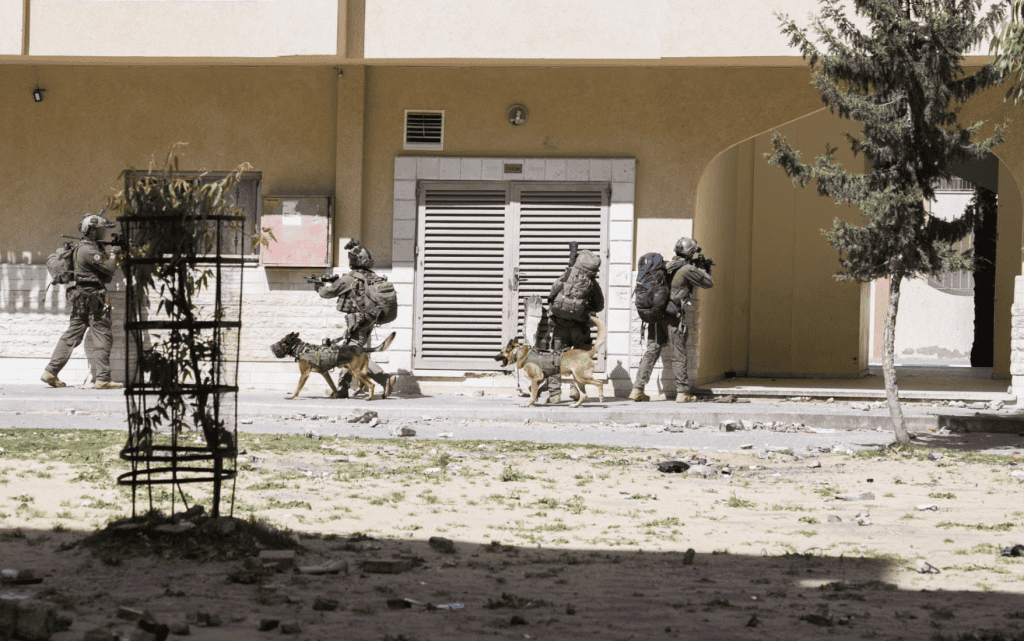
The Israel Defense Forces continue to seek out terrorists in Gaza, five months into the war against Hamas. The war has progressed through several stages, including intense aerial bombardment in October and a large ground maneuver in November. Now, the IDF is conducting raids to capture terrorists and eliminate threats re-emerging in some areas.
In southern Gaza, the IDF Commando Brigade of the 98th division, which has been fighting in Khan Younis since December, carried out a raid in a neighborhood called Hamad Towers. They located and apprehended 250 terrorists, the IDF said on March 6. The commandos were supported by elements of Israel’s internal security service Shin Bet and by the 7th armored and Givati infantry. This is the routine combination of forces that has been used in Khan Younis. “Some of the terrorists apprehended participated in the October 7th massacre, and some are terrorists from the Nukhba force. The terrorists are being interrogated and providing information that assists the continuation of the combat,” the IDF said.
An Israeli journalist who accompanied the forces provided an insight into the area being targeted. “The raid took place this week in the hottest spot in Gaza at the moment. Hamad Towers – the neighborhood built by the Qataris for the Hamas government in northwest Khan Younis. Five-story buildings with yards and parking lots. Not exactly a slum, but rather a dwelling for the well-connected,” noted Ron Ben-Yishai at Yediot.
The decision to go into the Hamad Towers was not part of the original plan for the three months of battle in Khan Younis that the 98th division has conducted. However, “it only became a target following the arrest and interrogation of terrorists who revealed that many Hamas operatives reside in the Hamad Towers and that there are many tunnels and likely rocket launch sites there,” Ben-Yishai noted. This is a glimpse into the future of IDF operations in Gaza. The IDF has also conducted raids in northern Gaza, returning to Shati, Zaytun and Beit Hanoun to sweep for terrorists. In each case, numerous threats have been eliminated.
Hamad marked the IDF’s first raid in the area, so it was still festooned with RPGs and weaponry. Nevertheless, the Hamas fighters are not as organized at the battalion level as they were when the war began. Instead, they fight in small groups, popping up to attack and then running away.
Although Israel now has less forces in Gaza, Hamas and other groups have also been reduced in size, so the IDF can tailor its operations in each area. For instance for the battle in Hamad Towers, the IDF used a number of elite units that are part of the Commando Brigade. These included the Maglan and Egoz units as well as Shayetet 13, the naval commandos. The IDF said it found a sniper cell commander, as well as RPGs, ammunition and “closed-circuit diving systems intended for military and terrorist use.” In another incident, the IDF targeted “two terrorists who participated in the October 7th Massacre in the Israeli community of Nir Yitzhak, as well as two platoon commanders and a cell commander in Hamas’ Nukhba forces.” In Beit Hanoun in northern Gaza, two terrorists were eliminated.
The tactics now at work in Khan Younis and in northern Gaza illustrate the likely future of the conflict in Gaza. This means smaller IDF forces fighting smaller groups of terrorists. Central Gaza now has IDF troops controlling a corridor across the strip, which has enabled their maneuvering into the north or south and prevented Hamas from doing the same. This looks a lot like the tactics the IDF uses in the West Bank against terrorists. In Jenin, for example, this is how the IDF has been fighting Palestinian Islamic Jihad over the last year and a half. Raids are conducted at night with the goal of targeting threats without keeping IDF forces there overnight. The IDF still has forces who stay overnight in Khan Younis, but most neighborhoods in northern Gaza have been returned to Gazans.







